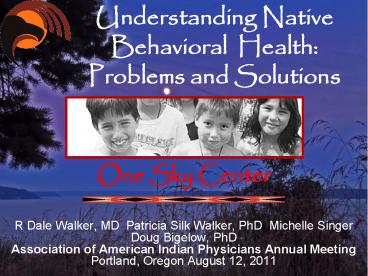Understanding Native Behavioral Health: Problems and Solutions - PowerPoint PPT Presentation
Title:
Understanding Native Behavioral Health: Problems and Solutions
Description:
Understanding Native Behavioral Health: Problems and Solutions One Sky Center R Dale Walker, MD Patricia Silk Walker, PhD Michelle Singer Doug Bigelow, PhD – PowerPoint PPT presentation
Number of Views:282
Avg rating:3.0/5.0
Title: Understanding Native Behavioral Health: Problems and Solutions
1
Understanding Native Behavioral Health Problems
and Solutions
- One Sky Center
- R Dale Walker, MD Patricia Silk Walker, PhD
Michelle Singer Doug Bigelow, PhD - Association of American Indian Physicians Annual
Meeting - Portland, Oregon August 12, 2011
2
One Sky Center Staff
Susan Michelle Patricia
Doug Dale
3
Native Communities
Advisory Council / Steering Committee
1.Opportunity 2. Research
7. Education
9. Mentorship
One Sky Center
4.Training 5. Consultation 6.
Technical Assistance
3.Excellence
8.Tribal Leadership
4
One Sky Center Outreach
5
Who are indigenous peoples?
- Indigenous peoples remain on the margins of
society they are poorer, less educated, die at a
younger age, are much more likely to commit
suicide, and are generally in worse health than
the rest of the population." - (Source The Indigenous World 2006,
International Working Group on Indigenous Affairs
(IWGIA) WHO
6
(No Transcript)
7
(No Transcript)
8
Native Healthcare Resource Disparities
9
Agencies Involved in B.H. Delivery
- 1. Indian Health Service (IHS)
- A. Mental Health
- B. Primary Health
- C. Alcoholism / Substance Abuse
- 2. Bureau of Indian Affairs (BIA)
- A. Education
- B. Vocational
- C. Social Services
- D. Police
- 3. Tribal Health
- 4. Urban Indian Health
- State and Local Agencies
- Federal Agencies SAMHSA, VAMC, Justice
10
Social Determinates of Health Whitehall Studies
- Within a hierarchical society, there is a social
gradient for morbidity and mortality. (Poverty,
sanitation, nutrition, and shelter are
controlled.) - Higher status folks live longer and healthier.
- Health Care Improvement Needs More Than Money
- Opportunity, Empowerment, Security, Control, and
Dignity.
www.thelancet.com Dec 9, 2006. Marmot Amartya
Sen 1998 Nicholas Stern 2004
11
Critical Elements for Native Peoples
- Self determination
- Ecology and environment
- Economic prosperity, fairness and equity
- Leadership and capacity strengthening
- Racism / dominance / imperialism
- Healing, services, systems, structures
- Cultural sustainability, protection, stewardship
- Land
- Human rights
12
DETERMINANTS OF HEALTH RACE AND ETHNICITY
- Economic
- Political
- Social
- Educational
- Employment
- Income
- Access to health care
- Environment
- Law Enforcement / Justice
- Home
- Colonialism as a Broader Social Determinant of
Health
13
Its the Economy, Stupid
- Recession hit minorities much harder than whites,
report says Overall, whites suffered a fraction
of the loss that hit Hispanics, Blacks. Orlando
Sentinel. - Race, Gender and Structural Inequalities in the
Great Recession and the Recovery (Joel Wendland,
Political Affairs) - America's massive racial wealth gap (The Week)
- Separate but unequal Charts show growing
rich-poor gap (CNN NEWS) - Its the inequality, Stupid (Zachary Roth The
Lookout) - White Americans Are A Record 20 Times Wealthier
Than Black Americans (Business Insider)
14
Building a Better AmericaOneWealth Quintile at
a Time
Michael I. Norton1 and Dan Ariely2
15
Recession Worsens Racial Wealth Gap
16
Who Rules America? Wealth, Income, and Power.
Net Worth
Financial Wealth
17
(No Transcript)
18
Behavioral Health Care Issues
19
Native Health Issues
- Alcoholism 6X
- Tuberculosis 6X
- Diabetes 3.5 X
- Accidents 3X
- Poverty 3x
- Depression 3x
- Suicide 2x
- Violence?
- Same disorders as general population
- Greater prevalence
- Greater severity
- Much less access to Tx
- Cultural relevance more challenging
- Social context disintegrated
20
Adult Serious Mental Illness By Race/Ethnicity
2001
SAMHSA Office of Applied Studies, 2001
21
Suicide Among ages 15-17, 2001
Death rate per 100,000
2010 Target
Females
Males
Total
American Indian
White
Black
Hispanic
Asian
Source National Vital Statistics System -
Mortality, NCHS, CDC.
22
Mental Illness A Multi-factorial Event
Psychiatric Illness Stigma
Edu., Econ., Rec.
Cultural Distress
Impulsiveness
Substance Use/Abuse
Hopelessness
Family Disruption/ Domestic Violence
Individual
Family History
Negative Boarding School
Psychodynamics/ Psychological Vulnerability
Historical Trauma
Suicidal Behavior
23
Models of Care
24
- Culture Values
- Philosophies
- Belief about causes of problems and solutions
- Local innovation, trial and error
- Medicinal use of wild plants and minerals
- Healing procedures
- Oral transmission of knowledge
- Community evaluation and acceptance
Practice (Service)
Best Practice
Science Scholarship
25
Community Based Logic Model
8. Long term (Impact)
7. Medium term
6. Short term
5. Operations Manual
4. Theory of Change
3. Strategy
26
(No Transcript)
27
Spectrum of Intervention Responses
Thresholds for Action
No Problems
Mild Problems
Severe Problems
Moderate Problems
28
Domains Influencing Behavioral Health A Native
Ecological Model
Risk
Protection
29
Individual Intervention
- Identify risk and protective factors
- counseling
- skill building
- improve coping
- support groups
- Increase community awareness
- Access to hotlines other help resources
30
Culture-Based Interventions
- Story telling
- Sweat Lodge
- Talking circle
- Vision quest
- Wiping of tears
- Drumming
- Smudging
- Traditional Healers
- Herbal remedies
- Traditional activities
31
What are some promising strategies?
32
Native Partnered Collaboration
State/Federal
Community-Based Organizations
Grassroots Groups
Research-Education-Treatment OHSU
"SHARED VISIONS BLENDING TRADITION, CULTURE AND
HEALTH CARE FOR OUR NATIVE COMMUNITIES
33
Areas for Action
Health Equity in all Policies
Good Governance
Fair Financing
Early child development and education Healthy
Places Fair Employment Social Protection
Universal Health Care
Responsibility
Gender Equity
Political empowerment inclusion and voice
34
NIDA Native Mentorship
Mentors 17
Mentees 21
35
Contact us at 503-494-3703 E-mail Dale Walker,
MD onesky_at_ohsu.edu Or visit our
website www.oneskycenter.org































